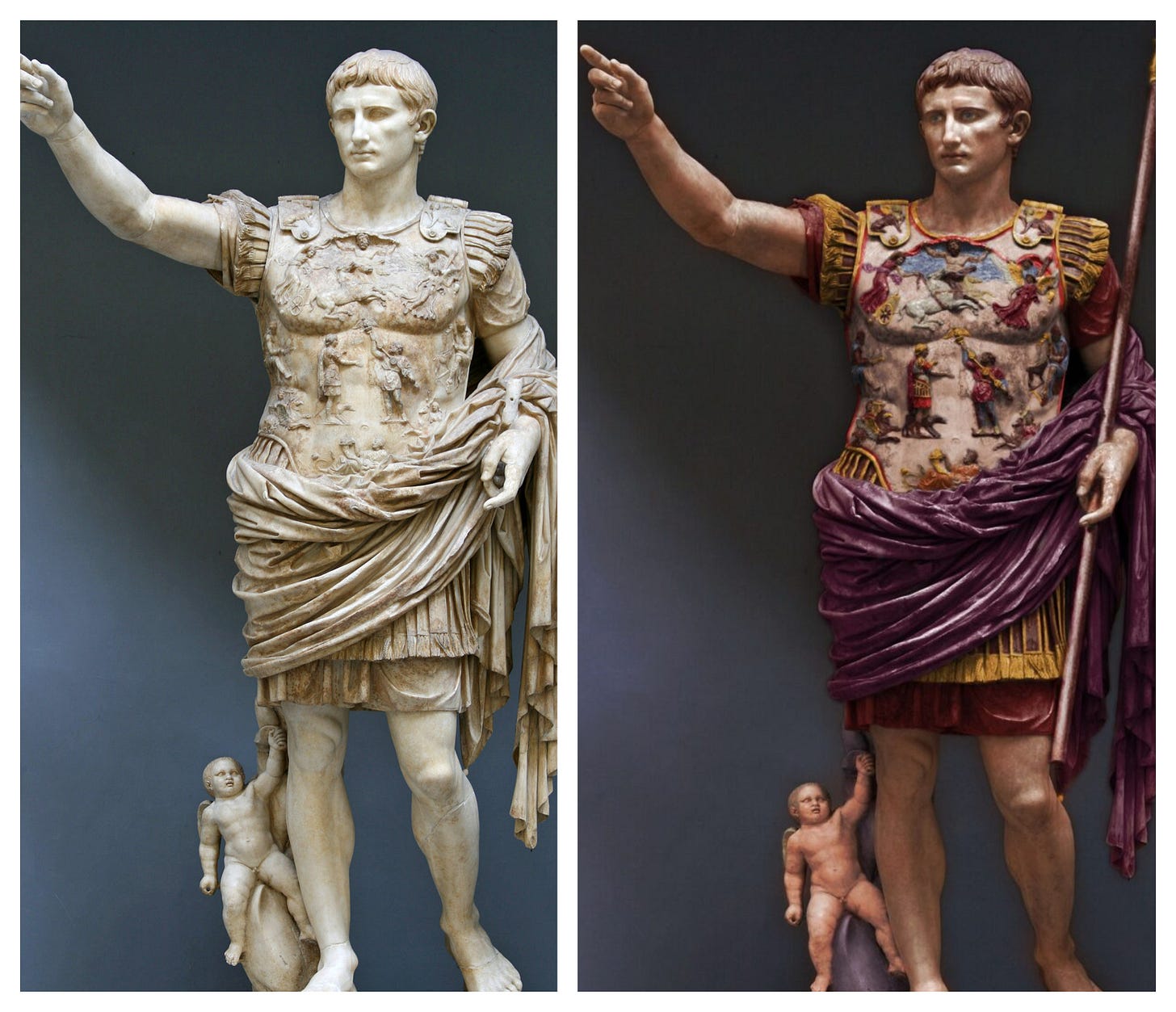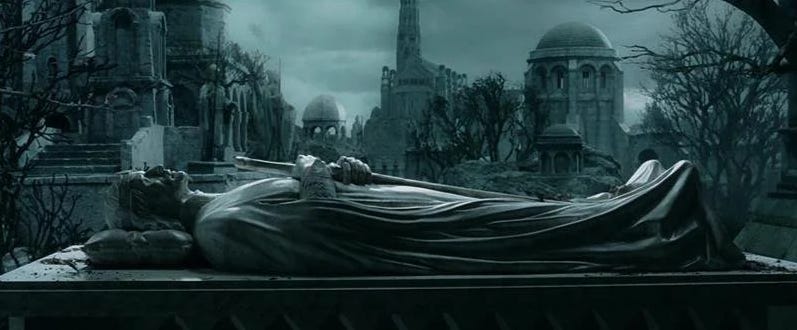The Whitewashed Classical World
Edited in June 2025.
I’m sure I’m not the only one who thought as a child that in the “olden days” the world was black and white. As the technology, fashion and character of life all change in their own way we are bound to tie them together unconsciously as a kind of package. Even looking back at things from the 00s purports an uncannily different world, tucked away behind the incidental aesthetics of yesterday’s videocameras and baggy jeans. While we grow past the childish notion of a sepia-toned world, these faint, emotional impressions remain a big part of how we relate to the past.
It’s noteworthy that I have no memory of ever saying this childhood belief - I remember it through others’ telling me that I said it. I am two whole levels removed.
The same is true of the Veronese paintings of the prophets Isaiah and Ezekiel shown above. They are depicted as statues stood on lionheaded plinths. In a sense they are “doubly-depicted”. Veronese paints them not as living men but as proud statues, shown in the white marble of classical antiquity. What could be a more enduring symbol of the foundations of Western Civilisation? This is, however, another illusion of the present imported into a view of the past. It is generally agreed among historians that a majority of classical marble sculptures were in fact originally painted in bright colours. What we see, like my black and white olden days, is an impression of an impression; Veronese painted them un-painted.
Throughout the 19th Century our fascination with the classical world was no longer fed only with Ancient Greek and Roman literature and antiquities hoarded along the “grand tour”, but came to be informed by the nascent field of academic archaeology. As we developed a more anthropologised picture of how these ancient societies were, discoveries of a less than sanitised kind were made. This was seen perhaps most famously at Pompeii, preserved under the ash in all its graffitied and debauched glory. In other words - in its life.
Our pristine image of Ancient sculpture is based on its dead, decayed state. That “sneer of cold command”1 so powerful in its blank austerity is the relic of the moribund Greco-Roman or indeed Egyptian world. The artists of the Renaissance and later periods were captivated and obsessed with this very image - the cool white marble of that prior “golden” age. Far from just being a mistaken vision of that remote period, it becomes an aesthetic in its own right, even long after we discard its historicity. Renaissance monumental sculpture was transfixed on this ideal, dovetailing with (and perhaps helping to propagate) associations of purity, nobility and honour that would persist for centuries.
The death mask of the prior peak of civilisation haunts us. As so much of high culture is founded on Graeco-Roman customs and even the very words that we use to discuss law, science or religion are too, this distant epoch is ever present to us. Until the actual living image of that time was dredged up, the images attached to that cultural source were inevitably drawn from ruins. To relate this to my recent blogs about language, the dignity and authority of words like dignity and authority in the English language is not entirely unrelated to their origin as latin derived words. When we talk about civilisation, apart from perhaps conjuring images of Kenneth Clark (or Sid Meier), tall columns of white marble jut into our heads. The very words themselves, rather than sounding earthy or mean stand like great pillars, signalling the very civilisation that we are referencing every time we speak aloud a fragment of its “dead” language. Just as a word like anthropology stands as an abstraction, its components foreign and unintelligible, so the unpainted marble statue stands aloof from the world.
Colour will fade as the colours of the original statues did - the “deadness” of this aesthetic is its immortality and lasting resonance - indicating that period of time that is always so present in our collective consciousness. Through remaining uncoloured, the marble ideal of the renaissance is untouched with mortality - with the dirt and grime of life that was preserved to be found at Pompeii. As Roger Scruton would put it, this smearing of colour transports the classical world out of Kairos and into Chronos.2 We no longer see it as a species of “timeless reality”, almost akin to myth,3 but instead as all-too-human history. Consider the distance between the Victorian image of Ancient Rome and that shown in I, Claudius - or for that matter in HBO’s Rome. While I am very fond of both of these series, their prosaic tendency yanks their significance down “from the universal to the parochial”, as said of Amazon’s abortive defacement of Tolkien’s Legendarium in an excellent youtube video from last year. I would argue that the same was achieved, far less shitly, by George R.R. Martin; his works being in essence a critique of Tolkien. While the TV show and its prequel series are glib and nasty in a way that it would be unfair to accuse the books of being, his splashing of colourful human drama onto the fantasy genre drags it once again through this desacralising filter. I am reminded of Oxford Movement Scholar J.A. Froude’s essay on Homer and Homeric Life in which he names the poet as “the truest historian”:
The prose historian may give us facts and names; he may catalogue the successions, and tell us long stories of battles, and of factions, and of political intrigues; he may draw characters for us, of the sort which figure commonly in such features of human affairs, men of the unheroic, unpoetic kind -the Cleons, the Sejanuses, the Tiberiuses, a Louis Quatorze, or a great Frederick, in whom the noble element died out into selfishness and vulgarity. But great men, and all men […] lie beyond prose, and can only be really represented by the poet. This is the reason why such men as Alexander, or as Caesar, or as Cromwell, so perplex us in the histories, because they and their actions are beyond the scope of the art through which we have looked at them. We compare the man as it represents him, with the track of his path through the world. The work is the work of a giant; the man, stripped of the vulgar appendages with which the stunted imagination of his biographer has set him off, is full of meannesses and littlenesses, and is scarcely greater than one of ourselves. Prose, that is, has attempted something to which it is not equal. It describes a figure which it calls Caesar; but it is not Caesar, it is a monster. For the same reason, prose fictions, novels, and the like, are worthless for more than a momentary purpose. The life which they are able to represent is not worth representing, except to itself. There is no person so poor in his own eyes as not to like a looking-glass; and the prose age may value its own image in the novel; but the value must be contented to be ephemeral. Thus it is with the poet's art as with the sculptor's: sandstone will not carve like marble, its texture is too loose to retain a sharply moulded outline. And so it is with men, and with the doings of men, which are the poet's materials-if they are true, noble, and genuine, they are strong enough to bear the form and bear the polish of verse; if loose or feeble, they crumble away into the softer undulations of prose.4
While the Lord of the Rings is not poetry, the poetic sense that it holds throughout lends it a timelessness akin to what classical civilisation and its epic poetry signifies to us.
And long there he lay, an image of the splendour of the Kings of Men in glory undimmed before the breaking of the world.
There is no accident in the aesthetic employed here. If one watches the scene shown in the film it is striking how the colour palette washes out as Aragorn’s body fades into his effigy. He is no longer Aragorn alive, bound to the colour of mortality, but is now an image of the splendour of the Kings of Men. His personal identity and mortal habits have been shed and he is displayed in the moonlike colours of ancient statuary. He is kingship itself. Veronese painted the prophets as plain statues for the same reason - to present them as immortal symbols. A more prosaic novelist could not communicate that same sense no matter how colourful and multifaceted a character they wrote him as, nor how well thought-out a tax policy they had him implement in Gondor. As Froude put it, prose fiction of that kind “must be contented to be ephemeral”. The same can be said for any image of the past that aims overly to “humanise” it.
However vivid and vibrant this different image of the classical world or of its mirrors in fiction may be, it cannot suffice for that everpresent ideal. That “humanity” that we are endlessly seeking to restore to our images of history cannot carry itself with any authenticity through to today, besides in achingly sentimental platitudes that “they were just like us”, which gets no one anywhere and does great disservice to the utter phenomenal transformation of their world into ours. Back to my starting point of a child’s naive view of the past and the emotional weight that this vision holds, this aesthetic “accident” of unpainted stone, if we wish to put it that way, has become fastened to things that aren’t only important but lastingly true, arguably over and above what a more “accurate” representation of the classical period can convey. It is not this ephemeral, mortal sense of the past that should, could or does live on through the ages.
“They would not think to lie so long.”5
We have gone a long way to explaining and even defending what can be seen as an illusory, even mistaken vision of the classical world, but there are other angles to address. As explored in Robert Holland’s excellent book The Warm South, the Mediterranean world itself has always played a crucial role in shaping British cultural consciousness, far beyond the memory of Rome. Indeed, as explored in the book, this memory and valorisation frequently stood as an impediment to British understanding of the real, living Mediterranean world. This theme will be explored fully in a later post that will act as a kind of review of that book which was such a pleasure to read.
Thank you as ever for reading.
Percy Bysshe Shelley, Ozymandias.
Chronos being time as the sequence of events and Kairos qualitatively distinct moments, for more see Mircea Eliade’s concepts of sacred and profane time, or Roger Scruton’s discussion of Chronos and Kairos in his book Wagner’s Parsifal.
Ernst Jünger - can never find the actual source!
James Anthony Froude, The Dissolution of the Monasteries and Other Essays, p87-8.
Philip Larkin, An Arundel Tomb. Larkin’s famous poem ending in the ambivalently meant line “What will survive of us is love”, concerns the two effigies of an Earl and Countess at Chichester Cathedral who have been carved hand in hand. Larkin argues that this “sculptor’s sweet commissioned grace” has transformed their legacy into a fiction of eternal love.




